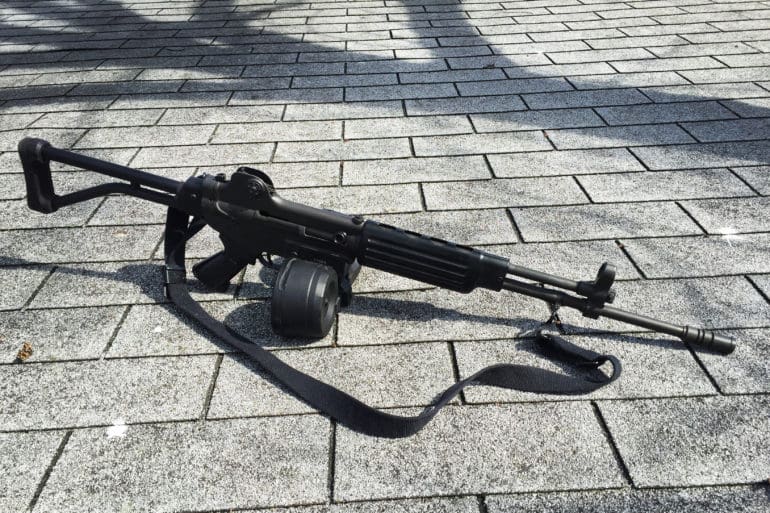Twenty-six years ago, from April 29 to May 4,1992, much of Los Angeles was ablaze. In the aftermath of the Rodney King verdict, South Central L.A. was consumed by riots and looting. Homes and business were burglarized and destroyed by arson. Law-abiding people and business owners were mugged, beaten and robbed.
The LAPD pulled out and basically told folks in the worst-hit areas that they were on their own. But a small section of Los Angeles known as Koreatown, located just north of South Central, didn’t burn. Why? Because the Korean business owners banded together, exercised their Second Amendment rights and protected their property, their businesses, and their livelihoods. Here are some of the news reports from the riots.
They were well armed and they defended themselves. Let’s take a look at some of the guns they used.
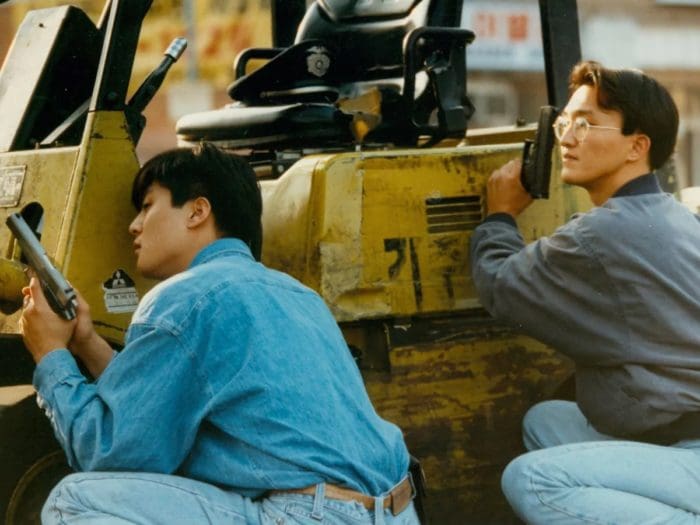
Two Korean Americans take cover behind a forklift during an exchange of gunfire between store owners and looters.
We have a GLOCK and what appears to be a stainless 1911. This was back in 1992, so the GLOCK more than likely is the Model 19. The .40 S&W while just recently introduced a couple of years prior, was more popular in the law enforcement market than the civilian market. This was before the Clinton Assault Weapons Ban, so 15- and 17-round magazines were easy to get.
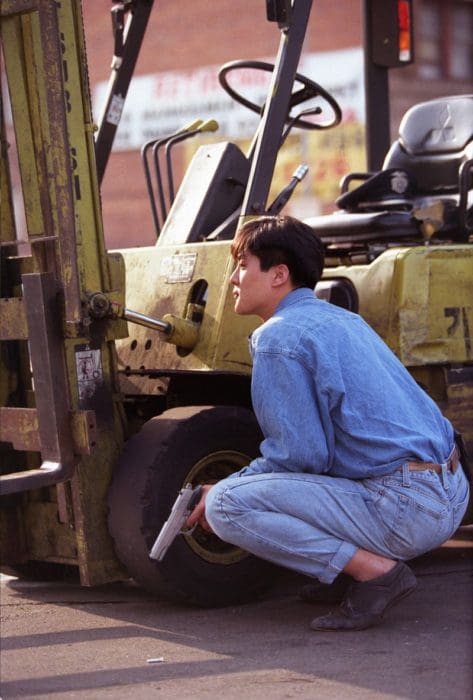
What appears to be a 1911 actually isn’t. It’s a Colt Double Eagle. They were a 1911 Slide and Barrel on a double action frame and were made only for a short period of time. They were chambered in 9mm, .40 S&W, .45 ACP, and 10mm Auto and used standard 1911 magazines. They were Colt’s answer to the SIG Sauer P220 and the S&W Model 4506/4566 line.
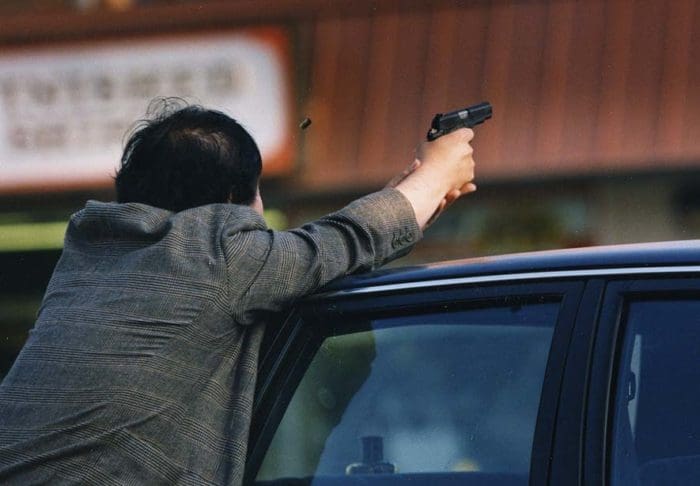
Korean supermarket employee returns fire from drive-by shooters at the corner of Western Avenue and 5th Street while attempting to protect the market from looters.
This gentleman is shooting what appears to be your standard period Colt Model 1991 Commander. It came from the factory with G.I. sights and a ring hammer. They used the Series 80 safety block and came with a stainless barrel. They were a more affordable option from Colt and that made them popular.
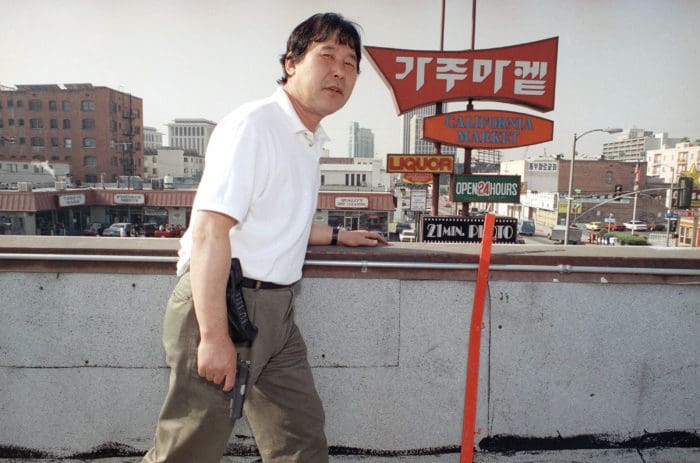
Store owner Richard Rhee keeps vigil on the roof of his grocery store.
Here’s a blued Colt Government Model .380 and an equally impressive period cellphone. Specifically a black Motorola DynaTAC commonly known as the “brick”. The Government Model .380 was part of Colt’s .380 Concealed Carry line back before the .380 pocket pistol market took off with guns like the Kel-Tec P3AT and the Ruger LCP.

This is a Korean store employee armed with a Norinco made MAK-90 AK pattern rifle. The fully-enclosed front sight hood is the give-away. Norinco Type 56s and MAK-90s had them while your Eastern European and Egyptian made guns had the standard winged sight protector. There is also the George Bush import ban-compliant thumb-hole stock.

Here we see what appears to be a Benelli M3 and an unknown Over & Under shotgun. The Benelli M3 was and is a fantastic police shotgun. Semi-automatic with the ability to switch to pump action so the shooter can use low recoil shells that wouldn’t properly cycle in a gas driven gun like a Rmeington 11-87.
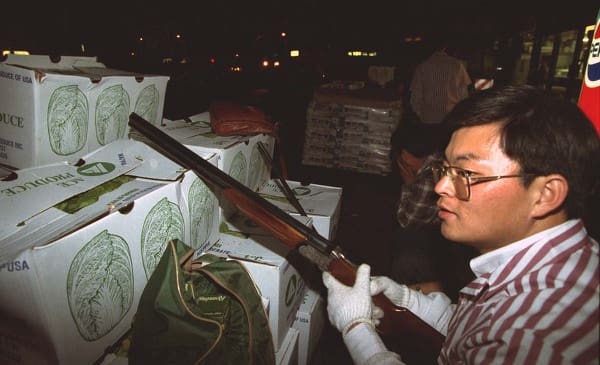
Armed volunteers take position behind cabbage boxes as they guard a market from approaching looters during the second day of riots.
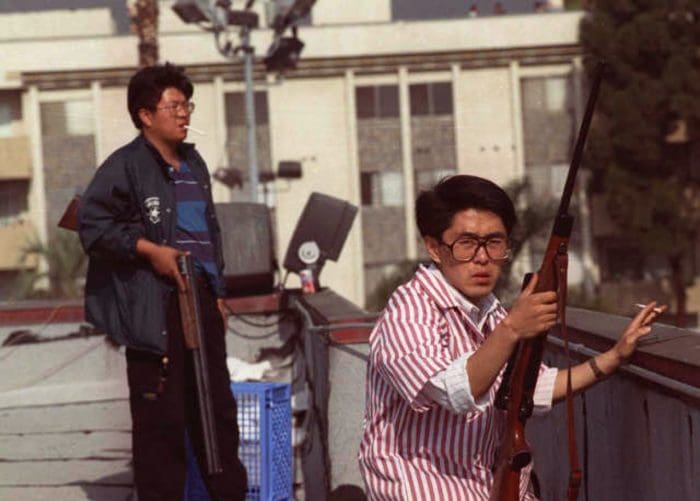

Personal hunting guns were also employed. Traditional over/under shotguns and a Remington 700 bolt action rifle. Sure, the O/U isn’t “tactical” but it’s better than harsh language when looters are trying to trash your store. And 00 buck will ruin anyone’s day.
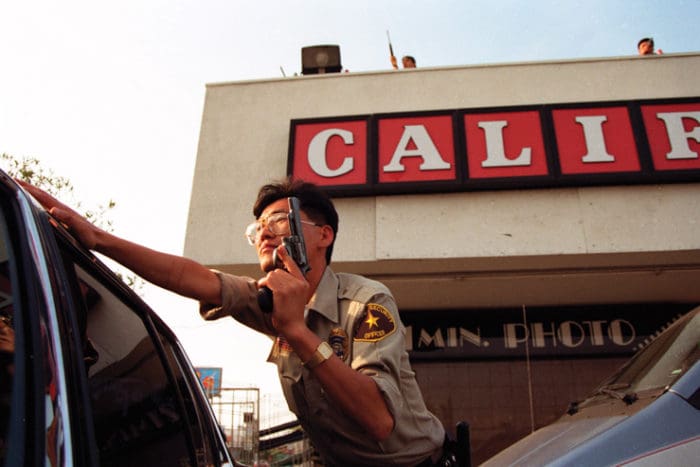
Korean Security Guard taking cover while his cohorts provide over-watch.
This security guard is armed with the ever popular wheel gun. Either a Smith & Wesson K-frame service revolver or a Taurus Clone. I’m leaning towards the Taurus due to the half lug on the barrel and it being a blued finish.
The blued S&W K-Frame in .38 Special had an exposed ejector rod like the Model 10 and the only .357 Magnum K-Frame with a half lug like that was the S&W Model 66 which was stainless. Taurus did a K-frame clone like the one shown in a blued finish, fixed sights, with a half lug, and came in either .38 Special or .357 Magnum.

The Mossberg 500 Tactical 8 Shot also played a role. Here you have a Korean grocery store employee standing guard inside the business with one.
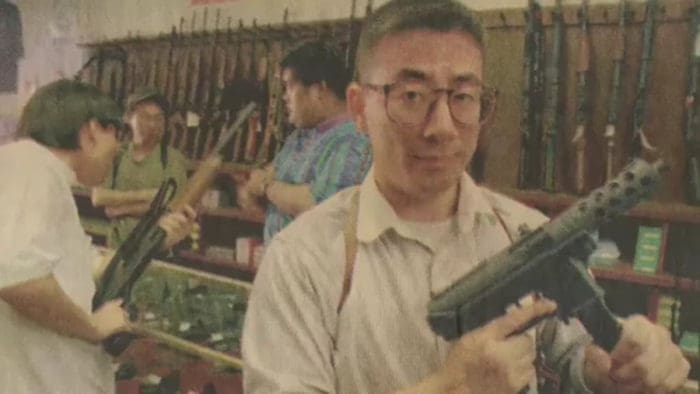
Period newspaper photo showing David Joo armed with a TEC-9.
This being the early 90s, the Intratec TEC-9 was an extremely popular (if misguided) pistol. It was designed by George Kellgren (current owner and lead designer of Kel-Tec) in 1985 and was a huge seller that stayed in production even during the Clinton AWB.
(The gentleman behind Mr. Joo is holding a Remington 870 with a LE Overfold stock.)
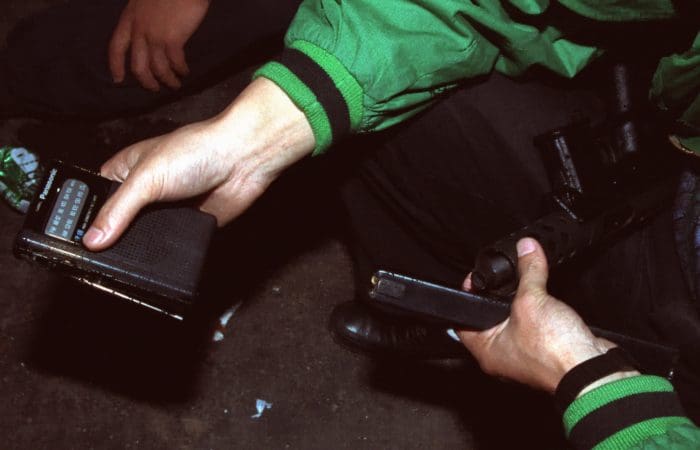
Another standard TEC-9 being held as someone listens to the latest news on the radio.

Here we have a young man carrying a chrome finished A.A. Arms Kimel AP-9 as the LAFD is attempting to save a building. The AP-9 strongly resembles the TEC-9.
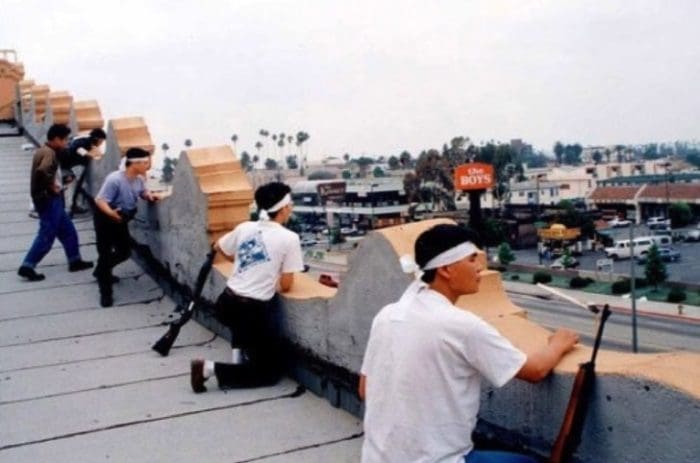
Korean store owners and employees keeping watch from the roof.
In this iconic photo, the gentleman on the far right is armed with a Ruger Mini-14. Chambered in 5.56x45mm, the Ruger Mini-14 was a very affordbale option at the time. Colt, Bushmaster, and Olympic Arms all made AR-15s, but prices for those were closer to $1,000. A Mini-14 cost around $250-$300 and 20- and 30-round magazines were easy to get. The man to the left of him has an unknown shotgun.
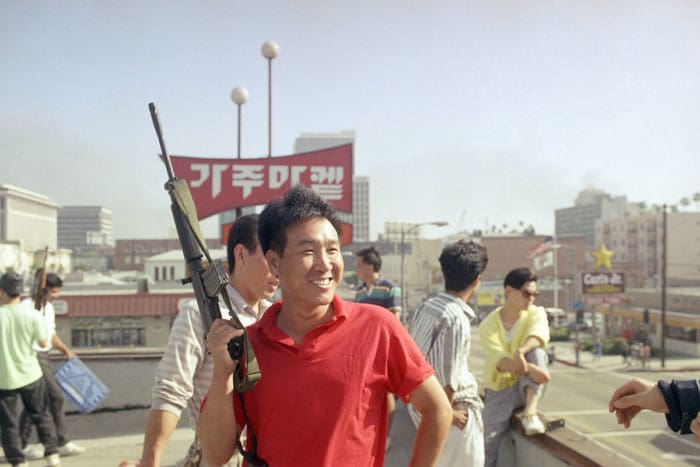
A Korean man carries an rifle to prevent looters from entering a grocery store .
Last but not the least, is a man armed with a Daewoo K1. This is a South Korean-designed and built rifle still used to this day by the ROK Army. It is a direct impingement design like an AR-15 and uses standard AR-15 STANAG pattern magazines and is chambered in 5.56 x 45mm.
Entering service as a replacement for the M3 “Grease Gun” SMG, it was designed with an 11.5-inch barrel and a small flash-hider like the Colt XM-177 carbines from Vietnam. Deawoo made a 16-inch model for the American civilian market.
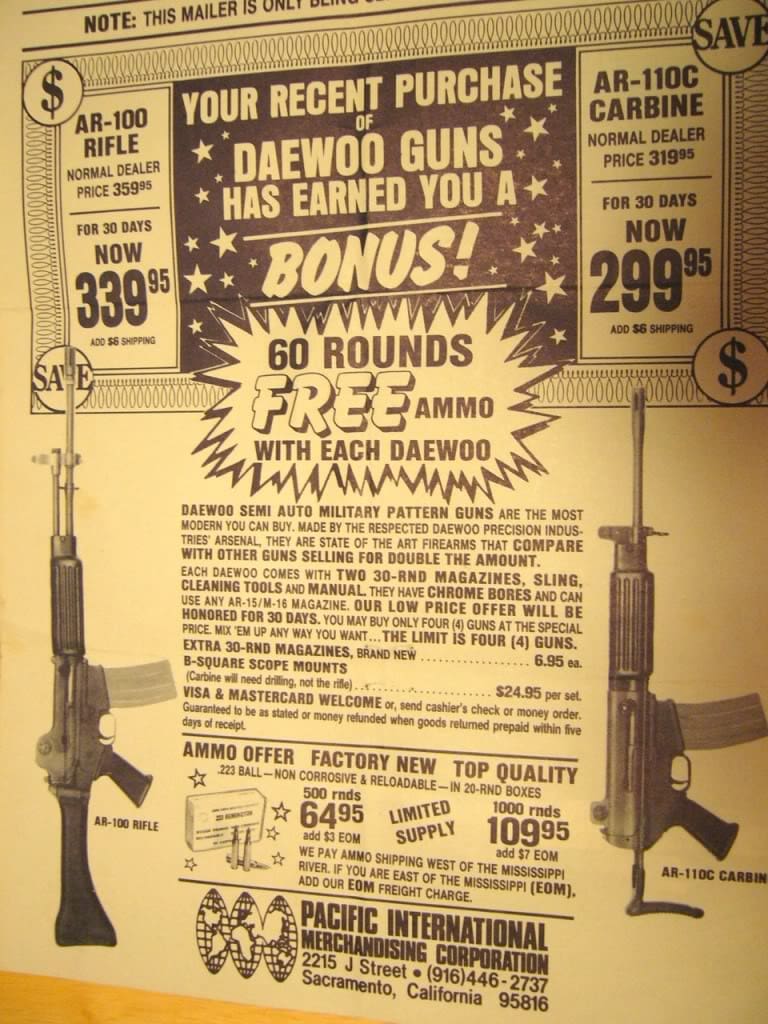
Sold in the US until George Bush import ban, it was sold under two names by the various importers. They were marketed as the Daewoo K1A1 Rifle and the AR-110C carbine and were priced to compete against the Ruger Mini-14.
AR-15s just weren’t as common at the time. They were pricey and had a number of lower-priced competitors. You had the influx of Norinco made AKs which were priced around $250 and SKS carbines, sometimes for under $100, There were the Daewoos and Mini-14s directly competing at about the same price point, not to mention common hunting guns.
On the handgun side of things. the revolver was still holding strong. GLOCK was just beginning to gain ground while the wonder nines of the era like the Beretta 92, S&W Model 5906, and SIG Sauer P226 were starting to sell like hot cakes. And there was always the classic 1911.
Just as today, these were Americans defending their property the best they could with the most effective tools they had. They were basically on their own, left to deal with the situation themselves.
Today, of course, everything you see above (with the exception of the security guard) is illegal in California. Open carry is forbidden, as are “high capacity” magazines. If you own a gun like that Daewoo K1, you were obligated to register it with the state.
And that photo showing people buying firearms to protect themselves and their property during the rioting is a relic, too. California now has a 10-day waiting period for all gun purchases. The 1992 riots lasted five days and did over $1 billion in property damage. If it happened today, anyone who didn’t already own firearms would be out of luck.
